Intro
Discover key facts about Sertraline, an antidepressant medication, including its uses, benefits, and side effects, to understand its role in treating depression, anxiety disorders, and mood disorders effectively.
The world of antidepressants is vast and complex, with numerous medications available to treat various mental health conditions. Among these, sertraline stands out as a widely prescribed and effective treatment for depression, anxiety disorders, and other mental health issues. Understanding sertraline, its benefits, and its potential side effects is crucial for individuals considering this medication as part of their treatment plan. As we delve into the realm of sertraline, it becomes apparent that there is more to this medication than meets the eye, with a rich history, diverse applications, and a significant impact on mental health treatment.
Sertraline, commonly known by its brand name Zoloft, has been a cornerstone in the treatment of depression, anxiety disorders, and other conditions since its introduction in the early 1990s. Its efficacy in improving mood, reducing anxiety, and enhancing overall quality of life has made it a preferred choice among healthcare professionals. However, like any medication, sertraline comes with its set of benefits and potential drawbacks, which are essential to understand for anyone considering or currently taking this medication. As we explore the world of sertraline, we will uncover five key facts that shed light on its mechanism, applications, and implications for mental health treatment.
The journey to understanding sertraline begins with recognizing its classification as a selective serotonin reuptake inhibitor (SSRI), a class of drugs known for their role in regulating serotonin levels in the brain. Serotonin, a neurotransmitter, plays a critical role in mood regulation, sleep, appetite, and other functions. By inhibiting the reuptake of serotonin, sertraline increases the availability of this neurotransmitter in the synaptic cleft, thereby enhancing neurotransmission. This mechanism of action underpins the therapeutic effects of sertraline, making it an effective treatment for a range of mental health conditions.
Introduction to Sertraline

History and Development
The history of sertraline is closely tied to the evolution of psychiatric medications in the late 20th century. As research into the neurochemical basis of mental health conditions advanced, so did the development of targeted therapies. Sertraline, with its selective action on serotonin reuptake, represented a significant step forward in treating depression and anxiety with greater specificity and fewer side effects. Its development and approval process involved rigorous clinical trials, demonstrating its efficacy and safety profile.Benefits of Sertraline

Therapeutic Uses
Sertraline's therapeutic uses extend beyond depression and anxiety to include several other conditions. It is prescribed for the treatment of OCD, characterized by unwanted and intrusive thoughts (obsessions) and repetitive behaviors (compulsions). Sertraline has also been found effective in managing panic disorder, which involves sudden feelings of terror that strike repeatedly and without warning, and social anxiety disorder, marked by an intense, persistent fear of being watched and judged by others. Its application in PTSD treatment helps individuals who have experienced traumatic events to manage their symptoms and improve their functioning.Side Effects and Precautions

Interactions and Contraindications
Sertraline can interact with other medications, including blood thinners, other antidepressants, and certain medications used to treat migraine headaches. These interactions can lead to increased risks of side effects or reduced efficacy of the medications. Additionally, sertraline is contraindicated in individuals taking monoamine oxidase inhibitors (MAOIs), another type of antidepressant, due to the risk of serotonin syndrome. Pregnant or breastfeeding women should also consult their healthcare provider before taking sertraline, as there may be risks associated with its use during these periods.Dosage and Administration

Treatment Duration
The duration of sertraline treatment can vary significantly among individuals, depending on the condition, response to treatment, and the presence of any side effects. For acute treatment of depression or anxiety, treatment may last several months. However, for chronic conditions or to prevent relapse, long-term treatment may be necessary. The decision to continue or discontinue sertraline should be made in consultation with a healthcare provider, who can assess the benefits and risks of ongoing treatment.Alternatives and Comparisons

Psychotherapy and Lifestyle Changes
Psychotherapy, including cognitive-behavioral therapy (CBT) and interpersonal therapy (IPT), can be an effective adjunct to medication or a standalone treatment for mild to moderate depression and anxiety. Lifestyle changes, such as regular exercise, a balanced diet, sufficient sleep, and stress management techniques, can also contribute to improved mental health and well-being. These non-pharmacological approaches can enhance the efficacy of sertraline and other medications, offering a holistic treatment plan that addresses both the biological and psychological aspects of mental health.Conclusion and Future Directions

Final Thoughts
In conclusion, sertraline represents a significant advancement in the treatment of mental health conditions, offering hope and relief to individuals affected by depression, anxiety, and other disorders. As we look to the future, it is essential to continue advancing our understanding of sertraline and other psychiatric medications, striving for more effective, safer, and more personalized treatments. By doing so, we can work towards a future where mental health care is more accessible, compassionate, and effective, ultimately improving the well-being of individuals and communities worldwide.What is sertraline used for?
+Sertraline is used to treat depression, anxiety disorders, and other mental health conditions by increasing the levels of serotonin in the brain.
What are the common side effects of sertraline?
+Common side effects of sertraline include nausea, diarrhea, insomnia, and sexual dysfunction. Serious side effects can include an increased risk of bleeding and serotonin syndrome.
Can I stop taking sertraline abruptly?
+No, it is not recommended to stop taking sertraline abruptly. This can lead to withdrawal symptoms or relapse of the underlying condition. Consult your healthcare provider before making any changes to your medication regimen.
We invite you to share your thoughts and experiences with sertraline and mental health treatment in the comments below. Your insights can help others better understand the complexities of mental health care and the role of medications like sertraline in managing these conditions. Additionally, consider sharing this article with friends, family, or healthcare professionals who may benefit from a deeper understanding of sertraline and its applications. Together, we can work towards promoting mental health awareness, reducing stigma, and supporting those affected by mental health conditions.
